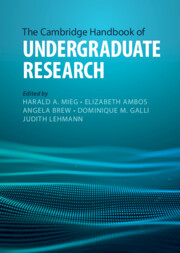Book contents
- The Cambridge Handbook of Undergraduate Research
- The Cambridge Handbook of Undergraduate Research
- Copyright page
- Contents
- Figures
- Tables
- Contributors
- Foreword
- Foreword
- 1 Introduction
- Part I Theory and Research on Undergraduate Research
- Part II Implementation, Approaches, Methods
- Part III Disciplines
- Part IV International Perspective
- 47 Introduction
- Part IV.1 Americas
- 48 Undergraduate Research in the USA
- 49 Undergraduate Research in Canada
- 50 Undergraduate Research in Argentina
- 51 Undergraduate Research in Brazil
- 52 Undergraduate Research in Colombia
- 53 Undergraduate Research in Mexico
- Part IV.2 Africa & Middle East
- Part IV.3 Asia & Oceania
- Part IV.4 Europe
- Part V Avenues for Developing Undergraduate Research
- Index
- References
48 - Undergraduate Research in the USA
Origins, Institutionalization, Growth, and Challenges
from Part IV.1 - Americas
Published online by Cambridge University Press: 11 August 2022
- The Cambridge Handbook of Undergraduate Research
- The Cambridge Handbook of Undergraduate Research
- Copyright page
- Contents
- Figures
- Tables
- Contributors
- Foreword
- Foreword
- 1 Introduction
- Part I Theory and Research on Undergraduate Research
- Part II Implementation, Approaches, Methods
- Part III Disciplines
- Part IV International Perspective
- 47 Introduction
- Part IV.1 Americas
- 48 Undergraduate Research in the USA
- 49 Undergraduate Research in Canada
- 50 Undergraduate Research in Argentina
- 51 Undergraduate Research in Brazil
- 52 Undergraduate Research in Colombia
- 53 Undergraduate Research in Mexico
- Part IV.2 Africa & Middle East
- Part IV.3 Asia & Oceania
- Part IV.4 Europe
- Part V Avenues for Developing Undergraduate Research
- Index
- References
Summary
Higher education in the United States is characterized by a decentralized organizational structure in both public and private colleges and universities across the fifty states and five major territories. Institutional diversity is distinguished by fundamental, self-identifying features that include but are not limited to mission and history, location, funding and endowment, architecture and facilities, campus culture, and degrees offered. The history of the US educational system is of interest to the development of undergraduate research in view of the early emergence of college student research in American higher education and US leadership in undergraduate research. In the US undergraduate research began through the senior capstone or honors thesis requirement. Beginning in the late 1990s the growing recognition of undergraduate research as a high-impact educational practice for student success resulted in expansion of undergraduate research across disciplines and institutions impacting curriculum design, academic culture, and student outcomes.
Keywords
- Type
- Chapter
- Information
- The Cambridge Handbook of Undergraduate Research , pp. 445 - 455Publisher: Cambridge University PressPrint publication year: 2022



